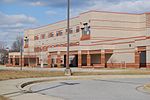Bellow's Spring Methodist Church
African-American history of Howard County, MarylandAfrican Methodist Episcopal churches in MarylandEllicott City, MarylandHouses in Howard County, MarylandHoward County, Maryland landmarks

Bellow's Spring Methodist Church (also called Mt. Pisgah AME Church) is a historic church in Ellicott City, Howard County, Maryland. The church was built between Rufus Thompson's farm and Thomas Christian's farm (also known as Bellow's Spring Farm) in the African American community of Jonestown. In 1899 the building was relocated to its present location along Route 108, taking the name Mt. Pisgah AME Church in 1901.The church is dwarfed by a modern church constructed adjacent to the building and the historical building is kept in poor condition with overgrowth covering the entrance.
Excerpt from the Wikipedia article Bellow's Spring Methodist Church (License: CC BY-SA 3.0, Authors, Images).Bellow's Spring Methodist Church
Old Annapolis Road, Columbia
Geographical coordinates (GPS) Address Nearby Places Show on map
Geographical coordinates (GPS)
| Latitude | Longitude |
|---|---|
| N 39.223333333333 ° | E -76.810277777778 ° |
Address
가든교회
Old Annapolis Road 8665
21045 Columbia
Maryland, United States
Open on Google Maps







